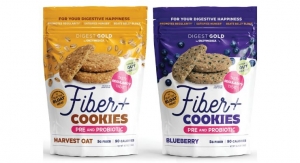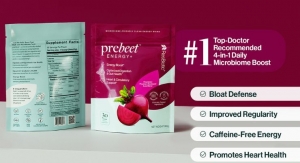Rebecca Wright, Editor06.01.11
When Nutraceuticals World first covered the soy market in January 1999 (in only our second issue), most experts painted a pretty rosy picture. For several reasons—e.g., health appeal, formulation benefits, rising consumer awareness—soy became a media darling and a hot target for product developers and marketers. And once FDA approved a health claim linking soy to a reduction in coronary heart disease risk, it was soy’s time to shine. But like most health trends, the good times couldn’t go on forever.
“Soy’s role in the marketplace has changed in recent years,” said Peter Golbitz, director of business development, Canada-based SunOpta Grains and Food Group. “Originally, it was a macro trend and a driver—every large company wanted soy as an ingredient. It wasn’t about health and wellness; it was just about soy.”
“But every trend has its cycle, and now soy is becoming a mature category and is a micro trend,” Mr. Golbitz added. “Few foods created a flurry like soy did, but now the attractiveness of soy is competing with other trends under the health and wellness category—e.g., whole grains, protein, antioxidants, etc.”
The U.S. Market
Buoyed by incredible momentum, the soy market reached more than $4 billion in sales in the U.S. by 2004, a point at which the market started to turn.
Fast forward to 2011 and it is very clear the soy market has matured. Growth has slowed or declined completely in most categories, leaving small pockets of opportunity in others.
Focusing on the bright side, Joe Jordan, content director, Soyatech, Southwest Harbor, ME, pointed out, “While the overall industry has been stuck in neutral since 2004, it has become increasingly clear that soy foods are not monolithic. Convenient, delicious foods containing soy protein continue to find success in the marketplace. Meat alternatives and energy bars, in particular, have experienced sustained sales growth even while the larger industry has slumped.”
Proving problematic for the category, recent research has not only questioned the efficacy of soy in relation to certain health issues, but also its safety, especially in relation to increasing the risk of cancer. While some experts claim these study results are unfounded, based on poorly designed trials, the negative aura surrounding soy continued to grow during the last several years.
“Negative information about soyfoods, mostly in the form of vague, poorly substantiated Internet rumors, have experienced a resurgence in the last couple of years, impacting the soyfoods market strongly in 2009,” Mr. Jordan said. “More positive news in 2010, including new scientific research, has seemed to turn the tide for the time being.”
Furthermore, soy is facing some stiff competition. Ironically, just as it offered consumers an alternative to dairy and meat, now other options like almond milk and fungus-based meat are moving in on soy’s territory and stealing market share.
According to a new report from Chicago, IL-based Mintel (“Soy Food & Beverages U.S., March 2011”), while some of soy’s plunge can be blamed on the recession and consumers cutting back on premium-priced soy items, competition from other heart healthy foods and good-tasting, soy-free milk alternatives are also challenging the industry and hampering soy sales.
“Aside from the depressed economy, consumers are experiencing soy burnout,” said David Browne, senior analyst, Mintel. “Not too long ago, American consumers were told soy is a ‘superfood’ they can’t get enough of, but now they’re hearing they may be getting too much. With soy aversion now a relevant concern, there are tons of competitive products available that have made it easy to switch to something new.”
Mintel/SPINS data show the soy food and beverage market declined 16% between 2008 and 2010 to $2.6 billion. And the market researcher predicts another 17% decline between 2010 and 2012.
While these numbers are somewhat shocking, Mr. Browne said they need some context. “When we put this most recent report out a couple of soy organizations said we were painting a poor picture of the market. But it is important to realize that these numbers don’t reflect sales from Trader Joe’s, Whole Foods or Wal-Mart, and a lot of consumers shop for soy products at the these stores,” he explained.
Given this variable, he said the picture could be different if those numbers were available. Further, he said, the soy market stands to perform better in the coming years when factoring them in.
Mintel/SPINS data point to the FDM (food, drug and mass) channel as holding the largest share of soy sales, accounting for 93% of total soy food and beverage sales, or $2.4 billion in 2010. “Supermarkets benefit from their full range of shelf-stable, frozen and refrigerated soy foods and beverages,” the market researcher said. “Furthermore, major retailers in both supermarket and mass merchandisers carry their own private label brands of soy food and beverages.”
On the other side of the spectrum, natural supermarkets captured $192 million, or 7% of the soy market, after stealing one percentage point of sales from FDM stores in 2008-10. While relatively small, Mintel said it is important to keep in mind that this channel is central to the soy market, as it’s a launching pad for a broad array of soy products that, once successful, gain distribution in FDM and other outlets.
Another point Mr. Browne wanted to drive home: Mintel’s latest report covered food and beverage products where soy is the primary ingredient. So he said this would exclude supplements as well as meal replacements. The latter segment, he said, is doing fairly well, so if that had been factored into the analysis the overall picture might have been affected.
Still, most experts agree that soy’s best days might be behind it. “A decade ago, the soy foods market was in a period of rapid growth, featuring constant innovation from nimble, entrepreneurial companies as consumer awareness of soy exploded and as soy foods became more convenient, familiar and accessible,” said Mr. Jordan.
“However, by 2004 the market of consumers willing to eat soy had become saturated—and nearly all of the independent companies who had zealously spearheaded innovation in the category were swallowed up by large food manufacturers—and growth quickly cooled,” he continued. “Since then, the market has grown very slowly—even declining in 2009 for the first time since we began tracking the category.”
Contrary to Mintel’s analysis, Soyatech’s data showed that 2010 was a year of mild recovery for the soy foods market, as overall sales grew by about 2%.
A Polarizing Ingredient
Like many hot ingredient trends, there is a certain period of exploration from companies in terms of product development. When soy was the “it” ingredient companies spent a lot of time perfecting formulations, specifically trying to tackle one of its most notable attributes: the taste.
Apparently, the taste issue is a polarizing one. For soy lovers, taste is the main reason they consume these products, while soy haters avoid it for the same reason. “At least half of survey respondents use soy because they like the taste. Interestingly, taste is also the main reason non-soy users steer clear of soy (45%),” Mintel said in its report.
Soyatech’s Mr. Jordan offered a similar view. “U.S. consumers generally identify soy as a healthful food. However, taste issues and concerns over the possibility of negative health implications continue to depress market growth, and we believe they will continue to do so in the near term,” he commented.
Regardless of the sensory issues, dedicated soy companies will continue to work out the formulation kinks. “There is ongoing work to improve the flavor and color of soy protein, making it possible to use in a wide variety of products,” said David Kraus, global applications manager for Israel-based Solbar, suggesting that consumers, especially Westerners, are looking for an invisible ingredient. “Soy is not something that is traditional to them; it is quite new and sometimes they are not happy with that. It seems people want the benefits of an ingredient that—in terms of taste and appearance—is not there.”
Perhaps ADM, Decatur, IL, has the answer. The company recently unveiled Clarisoy, an isolated soy protein that allows formulators to provide protein fortification in transparent, low pH beverage systems. “ADM’S Clarisoy is the world’s first vegetable-based protein that offers clarity and complete protein nutrition for low pH beverage systems,” commented Courtney Kingery, marketing and customer development manager, ADM Oilseed-Specialty Products. As background, in March 2011, ADM signed an agreement with Canada-based Burcon NutraScience to commercialize Clarisoy isolated soy protein.
This ingredient, Ms. Kingery said, will come in handy for sports and energy beverages. “ADM's market evaluations project double-digit growth in the sport and energy markets and the fruit and vegetable drink market through 2015,” she added.
Keith Parle, vice president of commercial cereal, bars & confectionery end-use markets, Kerry Ingredients & Flavours, Beloit, WI, agreed that taste is the number one consumer acceptance issue when it comes to soy. But he said the improvements on this front during the last several years have been very positive. “There has been continual development of soy masking technology and definite improvement in the last three or four years,” he said. “Just think: bars were terrible 10 years ago and I think they are definitely in a different place today.”
“I think flavor houses and formulators have done a great job improving products that were pretty awful and making them, from a sensory point of view, mainstream,” he added.
Another positive, according to Mintel, is that soy still has health benefits compared to meat, and many more innovations currently on the market compared to other non-soy meat and dairy alternatives, so it will likely remain a household presence among many health-conscious consumers.
In this vein, Mintel said, while the total market dropped more than 13% between 2008 and 2010, seven of the top 10 segments (energy bars and gels; frozen meat alternatives; condiments, dressings and marinades; refrigerated meat alternatives; cold cereals; refrigerated juices and functional drinks; and tofu) saw moderate growth, driven by demand for health and convenience, and fueled by innovation to meet these.
“Soyfoods: The U.S. Market 2011,” published in April by Soyatech, also highlighted the growth in the meat alternatives and energy bar categories. The latter, it said, witnessed 18% growth in 2010 vs. 2009, while the former posted 4% growth during the same period.
“Energy/nutritional bars and meat alternatives are also relatively large segments of the market that we expect to experience consistent growth over the next few years,” said Soyatech’s Mr. Jordan. “New blends of vegetable proteins that include soy are providing a basis for further flexibility and innovation in the category.”
According to Mintel’s report, soy-based energy bars and gels generated $522 million in sales, representing 20% market share in 2010 in FDM and natural supermarkets. “From 2008-10, the segment grew 21% benefitting from product innovations from leading companies, including Clif Bar, which offer good tasting products targeted to specific consumer segments.”
Mr. Jordan also discussed emerging opportunities for soy. “Smaller subcategories that have shown promise recently include soy-based condiments as well as frozen entrees, pizzas and convenience foods,” he said. “Soyfoods, if marketed properly, may gain some ground by leveraging the current success of ‘gluten-free’ foods where possible, but that will not be a long-term growth trend.”
Once considered a leader in the soy segment, Mintel said baby food (18% of the soy market) sales fell 48% to $477 million between 2008 and 2010, well behind energy bars in sales. Mr. Browne cited recalls of infant formula and the aggressive encouragement of breastfeeding as major causes of the sharp decline.
Refrigerated non-dairy beverages, which comprise nearly 15% of sales at $380 million, experienced a sales decline of more than 14% between 2008 and 2010.
As far as other trends go, SunOpta’s Mr. Golbitz offered, “There is continued growth in fermented soy products. In the future, we believe there will be more soy products with new flavors, additional benefits and new products like soy/juice blends. The tofu market has grown, and will continue to grow as it is made more convenient and available for consumers.”
Mr. Browne believes formulators will eventually move away from using soy as the main attraction. “Product developers may be able to gain new users by blending soy ingredients with nuts and grains to create innovative, better tasting and possibly more affordable food and beverages.”
Soy Isoflavones
According to Aparna Parikh, MBA, RD, senior marketing manager (for geniVida and Women’s health platform), DSM Nutritional Products, Parsippany, NJ, the isoflavone market has fluctuated over the years, even though consumer awareness of soy isoflavones and their health benefits is at 37% (Multisponsor surveys, 2010).
However, she said if you look at the market for condition-specific supplements (growing as a whole), such as menopause supplements (predominantly soy isoflavones and black cohosh) and bone health supplements, the categories have continued to grow (NBJ, 2010).
“Soy isoflavones (either as a total or their individual components) are to a large extent positioned for menopausal health and increasingly for bone health—the idea being that calcium and vitamin D by themselves are not enough,” Ms. Parikh explained. “This positioning is based on sound scientific evidence that soy isoflavones and their individual components play a key role in imparting health benefits for both these areas.”
Laurent Leduc, vice president, Health Division, Frutarom Americas, North Bergen, NJ, believes some of the struggles soy isoflavones have encountered during the last 10 years can be attributed to unfounded research. “The soy isoflavone market grew very rapidly to mid-2000, then saw steep decline during the past decade,” he said.
Mr. Leduc blamed the drop on tenuous research resulting in the negative portrayal of soy.
For the future, Mr. Leduc believes greater care needs to go into designing clinical trials on soy and soy isoflavones, with a particular focus on bioavailability. “You need to test to make sure subjects are actually getting isoflavones in the bloodstream,” Mr. Leduc said. “Today researchers are doing a better job understanding the differences in absorption but there is still a long way to go.”
Mr. Leduc mentioned this as a point of concern because the negative studies that impacted the market years ago did not test for the bioavailability of isoflavones. Yet, these studies still made broad (negative) conclusions about isoflavones.
Fortunately, Mr. Leduc said he has noticed increased interest in soy isoflavones during the past 12 months. “We are seeing interest in soy isoflavones for both supplement and functional food applications.”
As for health benefits, he said, “Menopause is still the primary use for isoflavones; secondary would be bone health (synergy with calcium); and incontinence would be the third.”
In terms of the latter, Frutarom carries a product substantiated by clinical studies on bladder control. The propriety blend, called Go-Less, combines pumpkin seed extract and SoyLife. “This is a new indication area for the U.S. market,” Mr. Leduc said. “We strongly believe in the synergy of these extracts for bladder health.”
Mr. Leduc also highlighted the important differences between natural and synthetic materials, especially in relation to Frutarom’s soy germ ingredient, SoyLife.
SoyLife is rich in isoflavones. But more than just an isoflavone concentrate, SoyLife offers the complete spectrum of natural soy compounds. This soy matrix, Mr. Leduc said, enhances the bioavailability of the isoflavones. “You need all the components of the matrix to benefit the body. You don’t have the same synergy when you are creating synthetic isoflavones. The soy matrix is there for a reason.”
Sharing his opinion on isoflavones, SunOpta’s Mr. Golbitz commented, “While I understand that isoflavones are in soybeans and they may be responsible for some of the health benefits, isoflavone supplements are not really a soy food, nor do I think they should be classified as a soy food per se. These are highly refined compounds that may or may not be very effective without all of the other healthful components of the soybean, particularly the protein.”
Offering another view, Ms. Parikh said isoflavones in soybeans can be broken down into three principal components: genistein, daidzein and glycitein, representing approximately 50%, 40% and 10% of the total soybean isoflavone content, respectively. “Genistein, the primary isoflavone in soy foods is the main circulating isoflavone in humans and has been the most thoroughly researched of the three—in humans and animals it has been experimentally the most efficacious,” she said. “geniVida, pure genistein, is an isoflavone that has been developed by DSM for use in dietary supplements and functional foods. It is a nature-identical, non-allergenic (and hormone-free) form of genistein that was created in the laboratory, thereby guaranteeing purity and consistency.”
“Studies indicate that geniVida can effectively relieve menopausal symptoms while helping to improve bone mineral composition,” Ms. Parikh continued. “In a randomized, placebo-controlled, double-blind clinical study, geniVida supplementation resulted in a 51% reduction in hot flashes and night sweats compared to only 27% for women in a placebo group.”
This new evidence, Ms. Parikh said, complements research showing that geniVida Bone Blend significantly increased bone mineral composition by up to 3.4% in post-menopausal women in comparison with women taking a calcium placebo who actually experienced bone loss.
The Global Outlook
While the U.S. soy market has had its struggles, the global outlook seems a bit more upbeat, according to estimates from Global Industry Analysts (GIA), San Jose, CA, and its new report, “Soy Foods: A Global Strategic Business Report.”
“Global demand for soy foods witnessed a significant increase during the past few years. Although the market witnessed 6% growth from 2006-2007, the market for soy supplements was adversely impacted by the anti-soy allegations that surfaced during that time,” the report said. “However, subsequent research and investigations rendered the allegations vague on grounds of incorrect research methodology used to come to such inferences. The soyfoods industry, thereafter, recovered from the controversies and has since been marching forward.”
GIA claims the worldwide soy foods market continues to be driven by increasing consumer awareness about the health benefits, including heart health, bone health and protection from cancer. “In addition to its high protein and fiber content, soyfoods provide low concentration of saturated fat, and are completely without cholesterol,” the report said. “Soyfoods have now emerged as a healthier and convenient dietary alternative in developed nations. Even in developing markets, soyfoods have found a place in the mainstream market and are provided as packaged foods in several varieties.”
Asia-Pacific represents the largest regional market for soy foods worldwide, according to GIA, with the U.S. trailing behind, followed by the European market. “Future market growth is expected to be driven by developing regional markets such as Asia-Pacific and Latin America,” the market research firm said.
“The shift of soy foods from small-sized natural food outlets to mainstream markets in developing countries could be attributed to market liberalization and improved supply network,” GIA reported. “The market for soy-based products expanded considerably with innovative and continuous launch of various soy products. Formerly, soy products found in retail stores were limited to tofu, bitter-tasting soymilk and poorly textured meat analogues. With advanced technology, development of tasty soy products has become easier. Several types of tasty soy beverages and snacks continue to hit the market every year.”
Despite the Health Benefits…
In large part, said Mr. Parle of Kerry, the soy industry reaped the benefits of government-funded research on soy during the past several years. But soy isn’t the only health ingredient backed by science these days. “A decade ago, if you wanted to pursue health benefits, soy was your only choice. But now there are many more choices,” he said.
Further, as the health food industry evolved, more companies realized that consumers were not prepared to wait to see if they could prevent heart disease or cancer, Mr. Parle explained. “As a result, there has been a move away from products that offer benefits years down the road toward those that offer more immediate benefits.”
While soy spent many years enjoying a solid healthy halo, recent years have not been as kind. Soy and breast cancer and soy and infant health are two areas that have been impacted recently.
Setting the record straight on the former, the Soyfoods Association of North America said, “Conflicting results from studies on soy’s connection to breast cancer often leave consumers confused. As more research is published, there is stronger support for the role of soy foods in reducing the risk of breast cancer—especially when soy is consumed during childhood and adolescence. More and more research also suggests that women who are at risk for developing breast cancer or who are breast cancer survivors can safely consume moderate amounts of soy foods—anywhere from a few servings a week to three servings a day.”
Despite its health benefits, high prices for soy motivated consumers to exchange soy foods for products based on less expensive ingredients such as whole grains, including wheat, barley and oats. Based on Mintel’s consumer survey, 22% of non-soy users say they do not buy soy because it is too expensive. “Soy prices are at an all-time high. This makes less expensive heart health products like whole grains more attractive,” Mintel explained. “This competitive set of products had a particularly negative impact on segments like cookies and snack bars, chips and pretzels, which each lost sales during 2008-10.”
Meanwhile, instead of focusing on specific benefits like reducing the risk of heart disease, many companies are stepping back to concentrate on soy’s generic attributes. In keeping with soy’s reputation as a health food, purity claims like “natural,” “organic” or “no additives and preservatives” rank in the top 10 claims soy food and beverages made during 2006-10, as monitored by Mintel’s Global New Products Database (GNPD). Such claims, the market researcher said, help brands stand out in meeting consumers’ desires for foods that promote wellness.
For others, promoting the health benefits of soy sometimes comes down to regulations. “Eating soy for its health benefits is a geographic issue. Companies are always trying to look for health claims but the reality is there are a lot of differences in regulations—especially in Europe, which has only approved one claim related to soy and cholesterol reduction,” said Solbar’s Mr. Kraus. “Regardless, people want to become healthier as they eat and soy is playing a nice role as a healthier alternative to unhealthy options.”
To address some of today’s broader issues, Mr. Parle said Kerry is adjusting its focus on consumer groups. “One part of the soy business is following a cost-yield path, sometimes using GMOs to make more affordable, more nutritious products,” he said. “The other part of the market is focusing more on affluent consumers, who are moving away from GMOs and buying organic as a safer alternative.”
As for those in the middle, Mr. Parle said, this has become a dead space. “This segment of the market is not doing well.”
“We’re interested in connecting with more educated, more affluent consumers and aggressively developing higher-end soy ingredients to appease their concerns,” Mr. Parle added. “These consumers are concerned less with price, and more with safety, environmental footprint and health. We are trying to do what we can on the soy side to attract these consumers.”
For example, he said Kerry has developed a 99.95% GMO-free soy product. “We hope to be at 99.99% very soon, meaning there will be virtually no GMOs in the material. Some folks are weary of GMOs, so this would address those issues.”
At the same time, the company is making the harvesting of its soybeans more environmentally friendly. “The whole idea is to completely avoid hexane in the production of soy,” Mr. Parle said. “We have developed a range of isolates produced without the use of hexane. Functionally and nutritionally they are almost identical to our other isolates.”
Soy’s Future
Soyatech’s Mr. Jordan predicted the soyfoods industry would continue to grow at a relatively slow rate (1-2% per year), which he said is typical of a mature food category.
“The lines between soyfoods and other healthful, vegetarian food options will become blurred as consumers will care more about convenient, delicious nutrition than about the source of protein,” he explained. “The impact of negative health stories will be largely blunted by the weight of scientific evidence finding soy to be a healthful component to a balanced diet. Taste concerns will be mitigated—though not erased—by further breakthroughs in processing technology.”
SunOpta’s Mr. Golbitz offered a similar perspective. “We believe the soy market will see slow, steady growth and be strong a decade from now. With rising food prices, soy will be an increasingly significant part of how we feed mankind,” he commented. “The developing world needs more protein, and with the high cost of food many will need to turn to vegetable protein.”
In the developed world, Mr. Golbitz believes soy will fare differently than in the developing world and be based on other factors, such as trends and demographics. “Soy will have its cycles, but we do think it will see growth in the future, especially if there are issues with dairy or meat safety,” he concluded.
“Soy’s role in the marketplace has changed in recent years,” said Peter Golbitz, director of business development, Canada-based SunOpta Grains and Food Group. “Originally, it was a macro trend and a driver—every large company wanted soy as an ingredient. It wasn’t about health and wellness; it was just about soy.”
“But every trend has its cycle, and now soy is becoming a mature category and is a micro trend,” Mr. Golbitz added. “Few foods created a flurry like soy did, but now the attractiveness of soy is competing with other trends under the health and wellness category—e.g., whole grains, protein, antioxidants, etc.”
The U.S. Market
Buoyed by incredible momentum, the soy market reached more than $4 billion in sales in the U.S. by 2004, a point at which the market started to turn.
Fast forward to 2011 and it is very clear the soy market has matured. Growth has slowed or declined completely in most categories, leaving small pockets of opportunity in others.
Focusing on the bright side, Joe Jordan, content director, Soyatech, Southwest Harbor, ME, pointed out, “While the overall industry has been stuck in neutral since 2004, it has become increasingly clear that soy foods are not monolithic. Convenient, delicious foods containing soy protein continue to find success in the marketplace. Meat alternatives and energy bars, in particular, have experienced sustained sales growth even while the larger industry has slumped.”
Proving problematic for the category, recent research has not only questioned the efficacy of soy in relation to certain health issues, but also its safety, especially in relation to increasing the risk of cancer. While some experts claim these study results are unfounded, based on poorly designed trials, the negative aura surrounding soy continued to grow during the last several years.
“Negative information about soyfoods, mostly in the form of vague, poorly substantiated Internet rumors, have experienced a resurgence in the last couple of years, impacting the soyfoods market strongly in 2009,” Mr. Jordan said. “More positive news in 2010, including new scientific research, has seemed to turn the tide for the time being.”
Furthermore, soy is facing some stiff competition. Ironically, just as it offered consumers an alternative to dairy and meat, now other options like almond milk and fungus-based meat are moving in on soy’s territory and stealing market share.
According to a new report from Chicago, IL-based Mintel (“Soy Food & Beverages U.S., March 2011”), while some of soy’s plunge can be blamed on the recession and consumers cutting back on premium-priced soy items, competition from other heart healthy foods and good-tasting, soy-free milk alternatives are also challenging the industry and hampering soy sales.
“Aside from the depressed economy, consumers are experiencing soy burnout,” said David Browne, senior analyst, Mintel. “Not too long ago, American consumers were told soy is a ‘superfood’ they can’t get enough of, but now they’re hearing they may be getting too much. With soy aversion now a relevant concern, there are tons of competitive products available that have made it easy to switch to something new.”
Mintel/SPINS data show the soy food and beverage market declined 16% between 2008 and 2010 to $2.6 billion. And the market researcher predicts another 17% decline between 2010 and 2012.
While these numbers are somewhat shocking, Mr. Browne said they need some context. “When we put this most recent report out a couple of soy organizations said we were painting a poor picture of the market. But it is important to realize that these numbers don’t reflect sales from Trader Joe’s, Whole Foods or Wal-Mart, and a lot of consumers shop for soy products at the these stores,” he explained.
Given this variable, he said the picture could be different if those numbers were available. Further, he said, the soy market stands to perform better in the coming years when factoring them in.
Mintel/SPINS data point to the FDM (food, drug and mass) channel as holding the largest share of soy sales, accounting for 93% of total soy food and beverage sales, or $2.4 billion in 2010. “Supermarkets benefit from their full range of shelf-stable, frozen and refrigerated soy foods and beverages,” the market researcher said. “Furthermore, major retailers in both supermarket and mass merchandisers carry their own private label brands of soy food and beverages.”
On the other side of the spectrum, natural supermarkets captured $192 million, or 7% of the soy market, after stealing one percentage point of sales from FDM stores in 2008-10. While relatively small, Mintel said it is important to keep in mind that this channel is central to the soy market, as it’s a launching pad for a broad array of soy products that, once successful, gain distribution in FDM and other outlets.
Another point Mr. Browne wanted to drive home: Mintel’s latest report covered food and beverage products where soy is the primary ingredient. So he said this would exclude supplements as well as meal replacements. The latter segment, he said, is doing fairly well, so if that had been factored into the analysis the overall picture might have been affected.
Still, most experts agree that soy’s best days might be behind it. “A decade ago, the soy foods market was in a period of rapid growth, featuring constant innovation from nimble, entrepreneurial companies as consumer awareness of soy exploded and as soy foods became more convenient, familiar and accessible,” said Mr. Jordan.
“However, by 2004 the market of consumers willing to eat soy had become saturated—and nearly all of the independent companies who had zealously spearheaded innovation in the category were swallowed up by large food manufacturers—and growth quickly cooled,” he continued. “Since then, the market has grown very slowly—even declining in 2009 for the first time since we began tracking the category.”
Contrary to Mintel’s analysis, Soyatech’s data showed that 2010 was a year of mild recovery for the soy foods market, as overall sales grew by about 2%.
A Polarizing Ingredient
Like many hot ingredient trends, there is a certain period of exploration from companies in terms of product development. When soy was the “it” ingredient companies spent a lot of time perfecting formulations, specifically trying to tackle one of its most notable attributes: the taste.
Apparently, the taste issue is a polarizing one. For soy lovers, taste is the main reason they consume these products, while soy haters avoid it for the same reason. “At least half of survey respondents use soy because they like the taste. Interestingly, taste is also the main reason non-soy users steer clear of soy (45%),” Mintel said in its report.
Soyatech’s Mr. Jordan offered a similar view. “U.S. consumers generally identify soy as a healthful food. However, taste issues and concerns over the possibility of negative health implications continue to depress market growth, and we believe they will continue to do so in the near term,” he commented.
Regardless of the sensory issues, dedicated soy companies will continue to work out the formulation kinks. “There is ongoing work to improve the flavor and color of soy protein, making it possible to use in a wide variety of products,” said David Kraus, global applications manager for Israel-based Solbar, suggesting that consumers, especially Westerners, are looking for an invisible ingredient. “Soy is not something that is traditional to them; it is quite new and sometimes they are not happy with that. It seems people want the benefits of an ingredient that—in terms of taste and appearance—is not there.”
Perhaps ADM, Decatur, IL, has the answer. The company recently unveiled Clarisoy, an isolated soy protein that allows formulators to provide protein fortification in transparent, low pH beverage systems. “ADM’S Clarisoy is the world’s first vegetable-based protein that offers clarity and complete protein nutrition for low pH beverage systems,” commented Courtney Kingery, marketing and customer development manager, ADM Oilseed-Specialty Products. As background, in March 2011, ADM signed an agreement with Canada-based Burcon NutraScience to commercialize Clarisoy isolated soy protein.
This ingredient, Ms. Kingery said, will come in handy for sports and energy beverages. “ADM's market evaluations project double-digit growth in the sport and energy markets and the fruit and vegetable drink market through 2015,” she added.
Keith Parle, vice president of commercial cereal, bars & confectionery end-use markets, Kerry Ingredients & Flavours, Beloit, WI, agreed that taste is the number one consumer acceptance issue when it comes to soy. But he said the improvements on this front during the last several years have been very positive. “There has been continual development of soy masking technology and definite improvement in the last three or four years,” he said. “Just think: bars were terrible 10 years ago and I think they are definitely in a different place today.”
“I think flavor houses and formulators have done a great job improving products that were pretty awful and making them, from a sensory point of view, mainstream,” he added.
Another positive, according to Mintel, is that soy still has health benefits compared to meat, and many more innovations currently on the market compared to other non-soy meat and dairy alternatives, so it will likely remain a household presence among many health-conscious consumers.
In this vein, Mintel said, while the total market dropped more than 13% between 2008 and 2010, seven of the top 10 segments (energy bars and gels; frozen meat alternatives; condiments, dressings and marinades; refrigerated meat alternatives; cold cereals; refrigerated juices and functional drinks; and tofu) saw moderate growth, driven by demand for health and convenience, and fueled by innovation to meet these.
“Soyfoods: The U.S. Market 2011,” published in April by Soyatech, also highlighted the growth in the meat alternatives and energy bar categories. The latter, it said, witnessed 18% growth in 2010 vs. 2009, while the former posted 4% growth during the same period.
“Energy/nutritional bars and meat alternatives are also relatively large segments of the market that we expect to experience consistent growth over the next few years,” said Soyatech’s Mr. Jordan. “New blends of vegetable proteins that include soy are providing a basis for further flexibility and innovation in the category.”
According to Mintel’s report, soy-based energy bars and gels generated $522 million in sales, representing 20% market share in 2010 in FDM and natural supermarkets. “From 2008-10, the segment grew 21% benefitting from product innovations from leading companies, including Clif Bar, which offer good tasting products targeted to specific consumer segments.”
Mr. Jordan also discussed emerging opportunities for soy. “Smaller subcategories that have shown promise recently include soy-based condiments as well as frozen entrees, pizzas and convenience foods,” he said. “Soyfoods, if marketed properly, may gain some ground by leveraging the current success of ‘gluten-free’ foods where possible, but that will not be a long-term growth trend.”
Once considered a leader in the soy segment, Mintel said baby food (18% of the soy market) sales fell 48% to $477 million between 2008 and 2010, well behind energy bars in sales. Mr. Browne cited recalls of infant formula and the aggressive encouragement of breastfeeding as major causes of the sharp decline.
Refrigerated non-dairy beverages, which comprise nearly 15% of sales at $380 million, experienced a sales decline of more than 14% between 2008 and 2010.
As far as other trends go, SunOpta’s Mr. Golbitz offered, “There is continued growth in fermented soy products. In the future, we believe there will be more soy products with new flavors, additional benefits and new products like soy/juice blends. The tofu market has grown, and will continue to grow as it is made more convenient and available for consumers.”
Mr. Browne believes formulators will eventually move away from using soy as the main attraction. “Product developers may be able to gain new users by blending soy ingredients with nuts and grains to create innovative, better tasting and possibly more affordable food and beverages.”
Soy Isoflavones
According to Aparna Parikh, MBA, RD, senior marketing manager (for geniVida and Women’s health platform), DSM Nutritional Products, Parsippany, NJ, the isoflavone market has fluctuated over the years, even though consumer awareness of soy isoflavones and their health benefits is at 37% (Multisponsor surveys, 2010).
However, she said if you look at the market for condition-specific supplements (growing as a whole), such as menopause supplements (predominantly soy isoflavones and black cohosh) and bone health supplements, the categories have continued to grow (NBJ, 2010).
“Soy isoflavones (either as a total or their individual components) are to a large extent positioned for menopausal health and increasingly for bone health—the idea being that calcium and vitamin D by themselves are not enough,” Ms. Parikh explained. “This positioning is based on sound scientific evidence that soy isoflavones and their individual components play a key role in imparting health benefits for both these areas.”
Laurent Leduc, vice president, Health Division, Frutarom Americas, North Bergen, NJ, believes some of the struggles soy isoflavones have encountered during the last 10 years can be attributed to unfounded research. “The soy isoflavone market grew very rapidly to mid-2000, then saw steep decline during the past decade,” he said.
Mr. Leduc blamed the drop on tenuous research resulting in the negative portrayal of soy.
For the future, Mr. Leduc believes greater care needs to go into designing clinical trials on soy and soy isoflavones, with a particular focus on bioavailability. “You need to test to make sure subjects are actually getting isoflavones in the bloodstream,” Mr. Leduc said. “Today researchers are doing a better job understanding the differences in absorption but there is still a long way to go.”
Mr. Leduc mentioned this as a point of concern because the negative studies that impacted the market years ago did not test for the bioavailability of isoflavones. Yet, these studies still made broad (negative) conclusions about isoflavones.
Fortunately, Mr. Leduc said he has noticed increased interest in soy isoflavones during the past 12 months. “We are seeing interest in soy isoflavones for both supplement and functional food applications.”
As for health benefits, he said, “Menopause is still the primary use for isoflavones; secondary would be bone health (synergy with calcium); and incontinence would be the third.”
In terms of the latter, Frutarom carries a product substantiated by clinical studies on bladder control. The propriety blend, called Go-Less, combines pumpkin seed extract and SoyLife. “This is a new indication area for the U.S. market,” Mr. Leduc said. “We strongly believe in the synergy of these extracts for bladder health.”
Mr. Leduc also highlighted the important differences between natural and synthetic materials, especially in relation to Frutarom’s soy germ ingredient, SoyLife.
SoyLife is rich in isoflavones. But more than just an isoflavone concentrate, SoyLife offers the complete spectrum of natural soy compounds. This soy matrix, Mr. Leduc said, enhances the bioavailability of the isoflavones. “You need all the components of the matrix to benefit the body. You don’t have the same synergy when you are creating synthetic isoflavones. The soy matrix is there for a reason.”
Sharing his opinion on isoflavones, SunOpta’s Mr. Golbitz commented, “While I understand that isoflavones are in soybeans and they may be responsible for some of the health benefits, isoflavone supplements are not really a soy food, nor do I think they should be classified as a soy food per se. These are highly refined compounds that may or may not be very effective without all of the other healthful components of the soybean, particularly the protein.”
Offering another view, Ms. Parikh said isoflavones in soybeans can be broken down into three principal components: genistein, daidzein and glycitein, representing approximately 50%, 40% and 10% of the total soybean isoflavone content, respectively. “Genistein, the primary isoflavone in soy foods is the main circulating isoflavone in humans and has been the most thoroughly researched of the three—in humans and animals it has been experimentally the most efficacious,” she said. “geniVida, pure genistein, is an isoflavone that has been developed by DSM for use in dietary supplements and functional foods. It is a nature-identical, non-allergenic (and hormone-free) form of genistein that was created in the laboratory, thereby guaranteeing purity and consistency.”
“Studies indicate that geniVida can effectively relieve menopausal symptoms while helping to improve bone mineral composition,” Ms. Parikh continued. “In a randomized, placebo-controlled, double-blind clinical study, geniVida supplementation resulted in a 51% reduction in hot flashes and night sweats compared to only 27% for women in a placebo group.”
This new evidence, Ms. Parikh said, complements research showing that geniVida Bone Blend significantly increased bone mineral composition by up to 3.4% in post-menopausal women in comparison with women taking a calcium placebo who actually experienced bone loss.
The Global Outlook
While the U.S. soy market has had its struggles, the global outlook seems a bit more upbeat, according to estimates from Global Industry Analysts (GIA), San Jose, CA, and its new report, “Soy Foods: A Global Strategic Business Report.”
“Global demand for soy foods witnessed a significant increase during the past few years. Although the market witnessed 6% growth from 2006-2007, the market for soy supplements was adversely impacted by the anti-soy allegations that surfaced during that time,” the report said. “However, subsequent research and investigations rendered the allegations vague on grounds of incorrect research methodology used to come to such inferences. The soyfoods industry, thereafter, recovered from the controversies and has since been marching forward.”
GIA claims the worldwide soy foods market continues to be driven by increasing consumer awareness about the health benefits, including heart health, bone health and protection from cancer. “In addition to its high protein and fiber content, soyfoods provide low concentration of saturated fat, and are completely without cholesterol,” the report said. “Soyfoods have now emerged as a healthier and convenient dietary alternative in developed nations. Even in developing markets, soyfoods have found a place in the mainstream market and are provided as packaged foods in several varieties.”
Asia-Pacific represents the largest regional market for soy foods worldwide, according to GIA, with the U.S. trailing behind, followed by the European market. “Future market growth is expected to be driven by developing regional markets such as Asia-Pacific and Latin America,” the market research firm said.
“The shift of soy foods from small-sized natural food outlets to mainstream markets in developing countries could be attributed to market liberalization and improved supply network,” GIA reported. “The market for soy-based products expanded considerably with innovative and continuous launch of various soy products. Formerly, soy products found in retail stores were limited to tofu, bitter-tasting soymilk and poorly textured meat analogues. With advanced technology, development of tasty soy products has become easier. Several types of tasty soy beverages and snacks continue to hit the market every year.”
Despite the Health Benefits…
In large part, said Mr. Parle of Kerry, the soy industry reaped the benefits of government-funded research on soy during the past several years. But soy isn’t the only health ingredient backed by science these days. “A decade ago, if you wanted to pursue health benefits, soy was your only choice. But now there are many more choices,” he said.
Further, as the health food industry evolved, more companies realized that consumers were not prepared to wait to see if they could prevent heart disease or cancer, Mr. Parle explained. “As a result, there has been a move away from products that offer benefits years down the road toward those that offer more immediate benefits.”
While soy spent many years enjoying a solid healthy halo, recent years have not been as kind. Soy and breast cancer and soy and infant health are two areas that have been impacted recently.
Setting the record straight on the former, the Soyfoods Association of North America said, “Conflicting results from studies on soy’s connection to breast cancer often leave consumers confused. As more research is published, there is stronger support for the role of soy foods in reducing the risk of breast cancer—especially when soy is consumed during childhood and adolescence. More and more research also suggests that women who are at risk for developing breast cancer or who are breast cancer survivors can safely consume moderate amounts of soy foods—anywhere from a few servings a week to three servings a day.”
Despite its health benefits, high prices for soy motivated consumers to exchange soy foods for products based on less expensive ingredients such as whole grains, including wheat, barley and oats. Based on Mintel’s consumer survey, 22% of non-soy users say they do not buy soy because it is too expensive. “Soy prices are at an all-time high. This makes less expensive heart health products like whole grains more attractive,” Mintel explained. “This competitive set of products had a particularly negative impact on segments like cookies and snack bars, chips and pretzels, which each lost sales during 2008-10.”
Meanwhile, instead of focusing on specific benefits like reducing the risk of heart disease, many companies are stepping back to concentrate on soy’s generic attributes. In keeping with soy’s reputation as a health food, purity claims like “natural,” “organic” or “no additives and preservatives” rank in the top 10 claims soy food and beverages made during 2006-10, as monitored by Mintel’s Global New Products Database (GNPD). Such claims, the market researcher said, help brands stand out in meeting consumers’ desires for foods that promote wellness.
For others, promoting the health benefits of soy sometimes comes down to regulations. “Eating soy for its health benefits is a geographic issue. Companies are always trying to look for health claims but the reality is there are a lot of differences in regulations—especially in Europe, which has only approved one claim related to soy and cholesterol reduction,” said Solbar’s Mr. Kraus. “Regardless, people want to become healthier as they eat and soy is playing a nice role as a healthier alternative to unhealthy options.”
To address some of today’s broader issues, Mr. Parle said Kerry is adjusting its focus on consumer groups. “One part of the soy business is following a cost-yield path, sometimes using GMOs to make more affordable, more nutritious products,” he said. “The other part of the market is focusing more on affluent consumers, who are moving away from GMOs and buying organic as a safer alternative.”
As for those in the middle, Mr. Parle said, this has become a dead space. “This segment of the market is not doing well.”
“We’re interested in connecting with more educated, more affluent consumers and aggressively developing higher-end soy ingredients to appease their concerns,” Mr. Parle added. “These consumers are concerned less with price, and more with safety, environmental footprint and health. We are trying to do what we can on the soy side to attract these consumers.”
For example, he said Kerry has developed a 99.95% GMO-free soy product. “We hope to be at 99.99% very soon, meaning there will be virtually no GMOs in the material. Some folks are weary of GMOs, so this would address those issues.”
At the same time, the company is making the harvesting of its soybeans more environmentally friendly. “The whole idea is to completely avoid hexane in the production of soy,” Mr. Parle said. “We have developed a range of isolates produced without the use of hexane. Functionally and nutritionally they are almost identical to our other isolates.”
Soy’s Future
Soyatech’s Mr. Jordan predicted the soyfoods industry would continue to grow at a relatively slow rate (1-2% per year), which he said is typical of a mature food category.
“The lines between soyfoods and other healthful, vegetarian food options will become blurred as consumers will care more about convenient, delicious nutrition than about the source of protein,” he explained. “The impact of negative health stories will be largely blunted by the weight of scientific evidence finding soy to be a healthful component to a balanced diet. Taste concerns will be mitigated—though not erased—by further breakthroughs in processing technology.”
SunOpta’s Mr. Golbitz offered a similar perspective. “We believe the soy market will see slow, steady growth and be strong a decade from now. With rising food prices, soy will be an increasingly significant part of how we feed mankind,” he commented. “The developing world needs more protein, and with the high cost of food many will need to turn to vegetable protein.”
In the developed world, Mr. Golbitz believes soy will fare differently than in the developing world and be based on other factors, such as trends and demographics. “Soy will have its cycles, but we do think it will see growth in the future, especially if there are issues with dairy or meat safety,” he concluded.



























